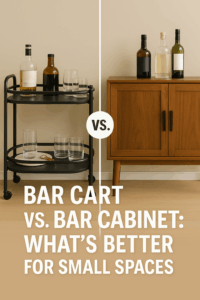The spaces we inhabit shape us in profound ways that extend far beyond aesthetics. Our homes—particularly in an era where many spend more time in them than ever before—function as both physical shelters and psychological environments that can either nurture or deplete our mental resources.
This relationship between domestic design and psychological wellbeing isn’t merely intuitive; it’s backed by a growing body of research indicating that thoughtful home environments can significantly enhance mental resilience, reduce stress, and support overall emotional health.
The Psychology of Space: How Environments Shape Our Minds
Environmental psychology—the study of how physical surroundings influence human behavior and wellbeing—provides compelling insights into why our homes affect us so deeply.
Stress Recovery and Restoration
According to research published in the Journal of Environmental Psychology, environments directly impact our ability to recover from stress and mental fatigue. This research draws on two complementary theories:
- Attention Restoration Theory (ART): Developed by psychologists Rachel and Stephen Kaplan, ART suggests that certain environments help us recover from mental fatigue by providing fascination without demanding directed attention.
- Stress Reduction Theory: Roger Ulrich’s research demonstrates that specific environmental qualities trigger parasympathetic nervous system responses that lower physiological stress markers.
As environmental psychologist Sally Augustin notes in her work with the American Psychological Association, “Our physical surroundings have a significant psychological impact. They can influence our mood, our ability to form social connections, and even our cognitive performance.”
The Neuroscience of Home
Neuroimaging studies reveal that different spatial characteristics trigger distinct brain responses:
- Rooms with high ceilings activate regions associated with abstract thinking and creativity
- Cluttered spaces increase activity in visual cortex areas linked to stress and distraction
- Natural elements and views stimulate parasympathetic nervous system activity, reducing cortisol levels
Research from the Academy of Neuroscience for Architecture shows that these neurological responses aren’t merely temporary—they shape our mental patterns over time through neuroplasticity, influencing everything from sleep quality to emotional regulation.
Essential Design Elements for Mental Wellbeing
Creating a home that supports psychological resilience involves attention to several key elements:
Light: The Foundation of Psychological Comfort
Light profoundly affects both mood and biological rhythms. A study in the Journal of Clinical Sleep Medicine found that daytime exposure to natural light improves sleep quality and reduces symptoms of depression.
Practical applications include:
- Positioning furniture to maximize exposure to windows
- Using light-filtering rather than light-blocking window treatments when privacy permits
- Incorporating layers of lighting (ambient, task, and accent) to create flexibility
- Selecting lightbulbs with appropriate color temperatures (warmer in relaxation spaces, cooler in work areas)
Spatial Organization and Cognitive Load
Clutter isn’t just an aesthetic issue—it’s a cognitive one. Research from Princeton University’s Neuroscience Institute found that visual clutter competes for neural representation, reducing the brain’s processing capacity and increasing distractibility.
Creating mentally restorative spaces requires:
- Establishing clear zones for different activities
- Implementing storage solutions that reduce visual complexity
- Creating breathing room between furniture pieces
- Maintaining clear pathways that allow easy movement
As organization expert Marie Kondo observes in her research on home environments, “The space in which we live should be for the person we are becoming now, not for the person we were in the past.”
Natural Elements: The Biophilic Connection
Biophilic design—incorporating elements of nature into built environments—delivers measurable psychological benefits. Studies from the Human Spaces Report show that spaces with natural elements increase wellbeing by 15% and creativity by 15% while reducing anxiety.
Effective biophilic strategies include:
- Incorporating houseplants, especially in frequently used spaces
- Using natural materials like wood, stone, and natural fibers
- Maximizing views of outdoor greenery
- Including water elements, from tabletop fountains to aquariums
Sensory Harmony: Beyond the Visual
While visual elements often dominate design discussions, our other senses profoundly impact psychological comfort:
- Acoustic design: Research from the University of California, Berkeley found that noise pollution increases stress hormone production and impairs cognitive performance. Sound-absorbing materials, white noise machines, and thoughtful speaker placement can create auditory comfort.
- Tactile elements: Varied textures stimulate positive sensory experiences. Incorporating natural fibers, layered textiles, and contrasting surfaces creates a sensorially rich environment that supports psychological wellbeing.
- Olfactory considerations: Our sense of smell connects directly to the brain’s emotional processing centers. Studies from the International Journal of Neuroscience show that specific scents like lavender and rosemary can reduce stress and improve cognitive function.
Creating Restorative Spaces: Room-by-Room Psychology
Different areas of the home serve distinct psychological functions. Optimizing each space for its primary purpose enhances overall mental resilience.
Entryway: The Psychological Transition Zone
The entrance to your home serves as a critical transition between public and private spheres. Environmental psychologists recommend creating a dedicated transition space that helps you decompress from outside stressors.
Design elements might include:
- A designated place to deposit bags, keys, and outer garments
- A bench or chair for the physical act of transitioning
- Personal elements that signal “home” and activate positive associations
- Organizational systems that prevent clutter accumulation at this critical juncture
Living Areas: Balancing Connection and Retreat
Living rooms often serve multiple psychological functions, from social connection to personal relaxation. According to research from the Center for Health Design, flexible arrangements that allow for both conversation and privacy best support mental wellbeing.
Consider:
- Seating arrangements that facilitate eye contact and conversation
- Lighting that can adjust for different activities and moods
- Personal elements that reflect identity and positive memories
- Technology containment to prevent digital distraction from dominating the space
Bedroom: The Sleep Sanctuary
Sleep quality directly impacts mental resilience. Research published in Sleep Health indicates that bedroom environments significantly influence both sleep initiation and maintenance.
Optimal design elements include:
- Cool, dark conditions with minimal light pollution
- Removal of work-related items and electronics
- Calming color palettes (blues, greens, and neutrals)
- Quality bedding that regulates temperature and provides comfort
Sleep scientist Matthew Walker, director of the Center for Human Sleep Science at UC Berkeley, emphasizes: “Your bedroom should be a sleep sanctuary and not an entertainment venue.”
Home Office: Focus Without Fatigue
With remote work becoming increasingly common, creating home workspaces that support cognitive function while preventing burnout is essential.
Research from the Journal of Environmental Psychology suggests optimal work environments include:
- Natural light positioned to avoid screen glare
- Views of nature or natural elements when possible
- Physical and visual separation from relaxation spaces
- Ergonomic furniture that prevents physical strain
- Plants, which have been shown to improve concentration by up to 15%
Home as Sanctuary: Psychological Safety Through Design
Beyond specific rooms, certain overarching principles transform any living space into a psychological sanctuary.
Boundaries: Creating Psychological Protection
Clear boundaries between the outside world and personal space are essential for mental restoration. This includes both physical boundaries (doors, walls, privacy screens) and psychological ones (rules about work hours, technology use, and outside intrusions).
Personalization: Identity Affirmation
Homes that reflect personal identity contribute to psychological wellbeing. Research from the Journal of Environmental Psychology shows that surroundings containing personally meaningful objects and arrangements provide emotional support during stressful periods.
Environmental psychologist Toby Israel explains in her book Some Place Like Home that “design psychology explores the connection between our psyche and our environments,” emphasizing how personal elements create an “environmental autobiography” that supports mental health.
Control and Agency: The Foundation of Resilience
Perhaps most importantly, spaces that provide a sense of control foster psychological resilience. Having agency over your environment—even in small ways—directly counteracts the helplessness often associated with stress and anxiety.
This might manifest as:
- Adjustable lighting and temperature
- Movable furniture that can adapt to changing needs
- Options for privacy and openness
- Personalized systems for organization and maintenance
Practical Implementation for Various Living Situations
The principles of restorative design can be adapted to diverse living circumstances:
Small Space Strategies
Research from Small Space Design Psychology shows that even minimal square footage can support mental wellbeing when:
- Vertical space is maximized through shelving and wall-mounted options
- Multi-functional furniture serves different needs at different times
- Sight lines are carefully managed to create a sense of spaciousness
- Decluttering becomes a regular practice rather than an occasional event
Shared Living Environments
When space is shared with others, psychological territory becomes crucial. Strategies include:
- Clearly designated personal areas, even if just a specific chair or shelf
- Negotiated agreements about shared space use and maintenance
- Visual and acoustic privacy options
- Personal touches that respect others’ preferences while affirming your identity
Rental Constraints: Non-Permanent Interventions
For those unable to make structural changes, impactful non-permanent options include:
- Light interventions (lamps, plug-in sconces, light therapy devices)
- Textiles that add color, texture, and acoustic benefits
- Freestanding furniture arrangements that define zones
- Removable wallpaper or large artwork for visual impact
- Potted plants and other natural elements
Frequently Asked Questions
What single design change has the biggest mental health impact?
While individual responses vary, research consistently shows that increasing natural light has the most universal positive effect on mental wellbeing. If structural changes aren’t possible, using full-spectrum lighting designed to mimic natural light’s qualities provides similar benefits.
How can I create more psychological space in a physically small home?
Psychological spaciousness often depends more on visual flow than actual square footage. Reducing visual clutter, creating clear sight lines, using mirrors strategically, and incorporating distant focal points all create a sense of expansiveness even in limited areas. Research from the Journal of Consumer Psychology shows that even simply raising ceiling-mounted lighting fixtures can create a perception of greater space.
Do minimalist designs benefit mental health more than maximalist ones?
Not necessarily. What matters is whether your environment supports your specific psychological needs. Some individuals experience the visual complexity of maximalist design as stimulating and comforting, while others find it overwhelming. The key is intentionality—spaces deliberately designed to support your particular cognitive style and emotional needs. Environmental psychologist Lily Bernheimer notes in her book The Shaping of Us that “the ideal level of complexity in our surroundings is highly individual.”
How do I balance multiple people’s needs in one space?
When designing for households with different preferences, incorporate flexible elements that can adapt to changing needs. Consider movable privacy screens, adjustable lighting with individual controls, and designated personal zones where each individual has greater autonomy over design decisions. Creating conversation areas with varied seating options often accommodates different comfort preferences simultaneously.
What if I can’t afford significant design changes?
Meaningful improvements don’t require substantial investments. Research shows that decluttering, rearranging furniture to improve flow, adding plants, adjusting existing lighting, and incorporating personal objects with positive associations all significantly impact psychological comfort with minimal financial outlay.
The Bottom Line: Your Home as a Mental Health Resource
Your home environment isn’t merely a backdrop to your life—it actively shapes your mental states, stress levels, and capacity for resilience. By approaching domestic design through the lens of psychological wellbeing, you transform your living space into a powerful resource for mental health.
As architect Witold Rybczynski writes in his exploration of domestic comfort, Home: A Short History of an Idea, “Comfort is more than a practical matter; it has a psychological dimension that relates to our sense of being.”
The most effective home environments aren’t necessarily the most picture-perfect or on-trend. Rather, they’re the ones that authentically support your psychological needs, providing both stimulation and restoration, connection and sanctuary, order and creativity. This balanced approach to domestic design doesn’t just create more beautiful spaces—it cultivates more resilient minds.




